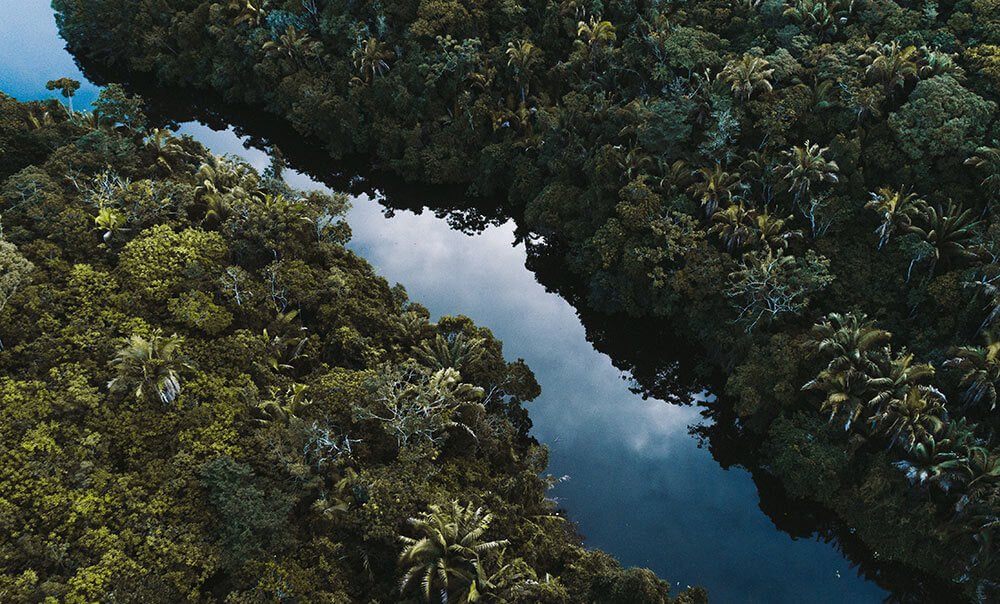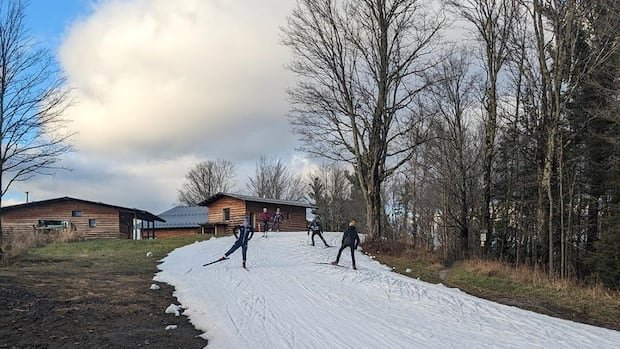Following last winter, one of the warmest on record, some ski hills and nordic centres may want to look into snow farming — the practice of stockpiling snow to extend the season.
Canada was one of the pioneers in a technique now used around the world, which actually has nothing to do with crops or livestock.
Snow farming can mean a few different things, from redirecting snow in the winter to stockpiling it over the summer. But unlike artificial snowmaking, these techniques work even if there isn’t a water source or freezing temperatures.
Banff Sunshine in Alberta, which doesn’t have access to a major water source, has been snow farming since the 70s.
“Because of our unique location, we had to get creative with how we ran our resort and collected our snow,” said Kendra Scurfield, whose family has owned and operated the resort since 1981. Scurfield, who is the company’s vice-president of brand and communications, says that snow farming started as a necessity and is especially important in seasons with less snow.
The mountain operations team uses fences made of bamboo and plastic to take advantage of the high wind.
“We’ll string a fence up, and as the snow falls and the wind blows, the fences kind of act as a net to catch all the snow,” said Scurfield. “Our team does study the wind patterns to know which will be the best zone for catching it.”
Once a fenced off zone is full, they’ll move that snow where it’s needed most. Like spreading icing on a cake, she said.
While Scurfield says that snow farming has been done in the Alps in some capacity since the middle ages, it’s been needed more across North America in recent years, and she says they will continue to do it as the climate changes.
Although still an uncommon practice in North America, snow farming is now used in various ski locations, including B.C.’s Baldy Mountain Resort, Vermont’s Craftsbury Outdoor Centre and Alberta’s Canmore Nordic Centre.
Using snow storage to help the early season
Jamie Temple works as snowmaking supervisor for the Canmore Nordic Centre. They’ve done some other kinds of snow farming in the past, but now focus mostly on what Temple refers to as snow storage — saving snow in piles covered with insulating materials.
“Snow storage is used to get a course in the early season when we don’t have snow,” he said.
In 2009, Canmore Nordic Centre first started the practice of making big snow piles in mid-December or early January, and covering them in a thick layer of sawdust over the summer. Then, the stored snow is excavated in the fall, around Thanksgiving, to make a track called Frozen Thunder.

This year, Frozen Thunder will be the longest ever — six or seven kilometres, compared to the original 2.2 km. Its capacity has also been extended from a practice space for high-performance athletes to an early recreational ski course.
“Last year, we got -15 C in October, and this year was pretty opposite — we didn’t get much snowmaking temperature and the precipitation was near nil,” he said.
“It seems to be very different year to year, rather than on a gradient … we are doing these processes to make sure that we can still bring quality product to people, even if climate change becomes much worse.”
Snow farming to manage weather unpredictability
The U.S. has also been suffering, with a study from the University of Waterloo estimating that the U.S. ski industry has lost more than $5 billion US over the past two decades because of human-caused climate change.
When Judy Geer and her husband Dick Dreissigacker bought Vermont-based Craftsbury Outdoor Centre in 2008, they turned it into a non-profit focused on lifelong sports, sustainable practices and being good stewards of the land.
“The climate’s changing — there’s no doubt about that — and as skiers, we’re especially aware of it,” she said. “Last year, everything thawed just a little bit too fast … and unfortunately it looks like it’s about to do the same this year. We had almost [15.6 C] yesterday, which is crazy, and we lost a lot [of snow].”
While Craftsbury has a few snowblowers that can make snow, they were looking for other solutions because it wasn’t getting cold enough by U.S. Thanksgiving in late November to be able to do so.
That’s where University of Vermont School of the Environment and Natural Resources professor Paul Bierman came in — approaching Craftsbury in 2018 to propose an experiment in snow farming.
They began with small test piles and eventually figured out that a thick layer of woodchips would allow them to keep 65 to 70 per cent of the snow. Soon after, they’d scaled up to a pile with almost 6,000 cubic metres of snow in an old pond.
As far as Geer and Bierman know, Craftsbury is the only place in the U.S. that engages in snow farming, but that it’s crucial to their ski season now, given the unpredictability of weather.

“It’s pretty amazing, there’s snow out there under those wood chips all summer,” said Geer. “And it means that when [U.S.] Thanksgiving comes for us, even if we don’t have cold enough temperatures to make fresh snow, we can spread out that snow and get between one and two kilometers of skiing.”
To reduce the environmental impact, many of the wood chips come from trees that fall on the trails, and the snow guns used to make the pile are powered by generators with a heat recovery unit that’s used to power their housing.
Aside from economic stability for Craftsbury and the surrounding local businesses, snow farming has also allowed them to do fun things with the snow, such as bring out a small track for the 4th of July for the town party.
“People doing flips and jumps and turns and having a blast on this little hill covered in snow in the middle of July,” said Bierman. “It was, that was probably the single most fun thing I’ve ever seen the stuff being used for.”




